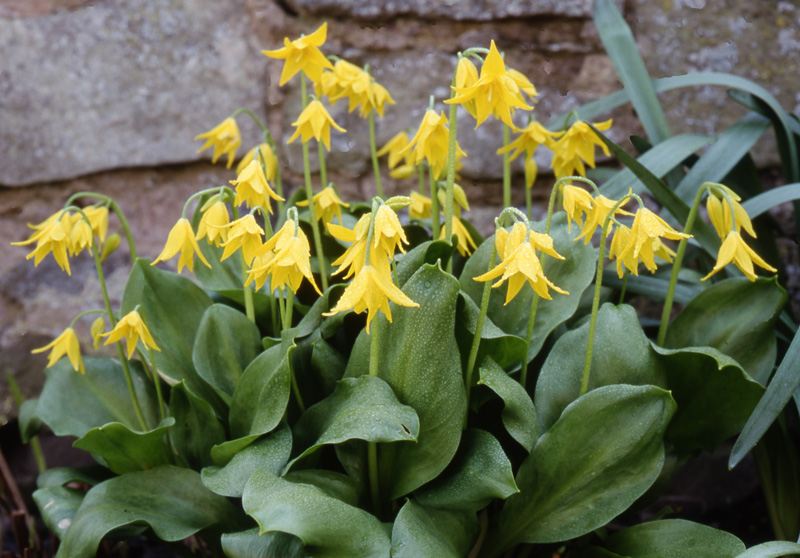Mar/Apr 2012: Erythronium tuolumnense ‘Spindlestone’ – March 2012
 I guess that the most widely grown of all erythroniums would be the hybrids including, ‘White Beauty’ and ‘Pagoda’. One often encounters mass woodland plantings of Erythronium revolutum due to its ability to set good quantities of seed, while the quite stunning E. tuolumnense is less often seen in gardens. The species in question here, is native to the Californian Sierra Nevada and is certainly only locally abundant, restricted to the Tuolumne County. It grows in open Chaparral (a unique shrubland community, endemic to this part of California and subject to wildfires) supporting a flora that is significantly summer drought-tolerant. The species can be found at an elevation of between 500m and 1100m preferring north-facing slopes. It is locally abundant and its formation of extensive clumps is noteworthy due to its ability to proliferate by vegetative increase from offsets. This is a feature that makes it an excellent garden plant as well its adaptability from dappled shade to a more open position.
I guess that the most widely grown of all erythroniums would be the hybrids including, ‘White Beauty’ and ‘Pagoda’. One often encounters mass woodland plantings of Erythronium revolutum due to its ability to set good quantities of seed, while the quite stunning E. tuolumnense is less often seen in gardens. The species in question here, is native to the Californian Sierra Nevada and is certainly only locally abundant, restricted to the Tuolumne County. It grows in open Chaparral (a unique shrubland community, endemic to this part of California and subject to wildfires) supporting a flora that is significantly summer drought-tolerant. The species can be found at an elevation of between 500m and 1100m preferring north-facing slopes. It is locally abundant and its formation of extensive clumps is noteworthy due to its ability to proliferate by vegetative increase from offsets. This is a feature that makes it an excellent garden plant as well its adaptability from dappled shade to a more open position.
Having grown and enjoyed the species for many years, it was not until the latter years of my time at Edrom Nurseries that I was to make an important visit to the marvellous nursery garden of Diana Aitchison in Northumberland. A good friend and customer, Diana was now ready to retire and invited Ron McBeath and myself down to see if we would like a few special plants. We looked on in amazement at two particular plants that she had developed in different parts of her extensive garden. The first was the now, well-known plicate snowdrop, Galanthus ‘Spindlestone Surprise’. The other was an amazing clump of Erythronium tuolumnense. Ron had grown this for many years whilst working at Jack Drake’s nursery, yet we realised that this was a very special form or a hybrid. Anyway we were given a generous piece and the name E. tuolumnense ‘Spindlestone’ was borne. It has a more compact nature than the species and has a greater number of flowers on each nodding stem. The combination of bright green, glossy leaves and the yellow flowers is very special. It bulks up well in almost any decent garden soil and benefits from a generous mulch of well-rotted horse manure and leafmould. In my experience this plant is completely sterile and can be lifted and separated during the dormant season.
Availability:
